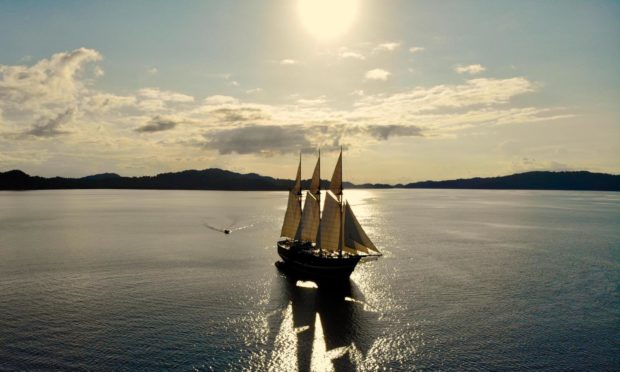Joining the Merchant Navy was one of the great job opportunities when I was growing up. I can hardly think of a household that didn’t have a few sons sailing the high seas, returning home with wonderful stories about far off places such as Rio de Janeiro and Bahia Blanca.
And so we immediately got out the atlas and traced a line with a pencil from Lochboisdale all the way across the Atlantic, through the Panama Canal and on south round Cape Horn. We were Robinson Crusoe and Ralph Rover and, later on, Joseph Conrad sailing through the adventurous islands of Sumatra and Java. Though when we looked out from the deck of the Claymore as we sailed to Oban we could only see Tiree and Coll.
The Merchant Navy continues to be central to world trade as well as being a major employer. There are more than 50,000 merchant ships sailing in all corners of the globe, employing more than 1,500,000 sailors, 22,400 of them from the United Kingdom.
In my own patch of the sea, CalMac ferries are not just lifeline services to the islands but a major and highly-regarded employer. They operate 34 vessels running from the Ardrossan-Brodick service in the south to the Stornoway-Ullapool service in the north, employing 1,700 people, including 200 at their Gourock headquarters.
But whether sailing to Sumatra or to Scrabster, one of the major issues ships have to deal with is pollution; 90% of the world’s trade is still moved by sea and more than 3% of global carbon dioxide emissions can be attributed to ocean-going ships. Conservation group Oceana states that: “If global shipping were a country it would be the sixth largest producer of greenhouse gas emissions. Only the United States, China, Russia, India and Japan emit more carbon dioxide than the world’s shipping fleet. Neverthless carbon dioxide emissions from ocean-going vessels are currently unregulated.”
Which is why I welcome a remarkable new development that has gathered pace in recent years; the building of eco-friendly trade ships to transport goods from one corner of the globe to the other. And not merely as a politically-correct and environmentally-friendly campaign but as a real and profitable proper shipping business. It’s back to the future with wind in their sails.
A handful of companies are engaged in this growing trade, including: Fairtransport, a company based in the Netherlands; Timbercoast working out of Germany; Trans Oceanic Wind Transport in France; and New Dawn Traders based in Bristol.
And their ships are beautiful – wooden with lovely traditional canvas sails. Of course there are also global container ships now fitted with high-tech sails made of extra-high tensile steel and alloys, with added solar panels and wave energy convertors to generate the energy required.
Even with Covid, the shipping trade is one that has an expanding future. As long as we want to drink coffee or tea, buy a car or build a home, eat a banana or drink orange juice this global trade will continue to grow.
It is market driven and, as long as our – often preposterous – demands exist, then someone will be willing to sell it to us. So if we want strawberries on Christmas Day, some company will transport them thousands of damaging miles across the oceans to sit on our plates. And if we want fresh salmon in the middle of winter, off we go to the supermarket to find it there freshly frozen from Alaska. It certainly didn’t swim here on its own.
I’ve always felt that our ferries should be equipped with sails to help them cross both the Minch and the North Sea. Aesthetically beautiful canvas sails flapping in the constant wind between Oban and Lochboisdale and between Shetland and Aberdeen would be best, though I’d be more than happy to see button-operated carbon sails as well.
I’m sure Murdo or Murdina could as easily press a button as climb the mast to unfurl the sails as you travel through a nice Force 10 in the sea of the Hebrides or the Pentland Firth!
My father-in-law joined the Merchant Navy as a cadet in 1948 sailing out of Leith. He told me the other day that the chief engineer he first sailed with was born on a sailing ship in 1890 on its way round Cape Horn. Think of the romance of it all. But mostly, think of his poor mother!
Angus Peter Campbell is an award-winning writer and actor from Uist
